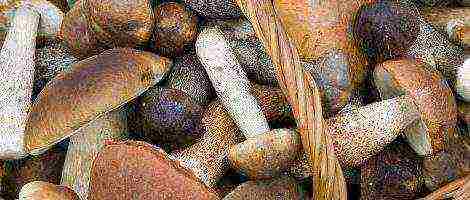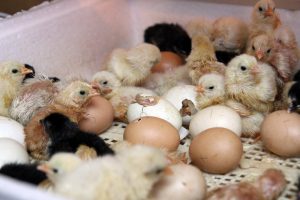Content
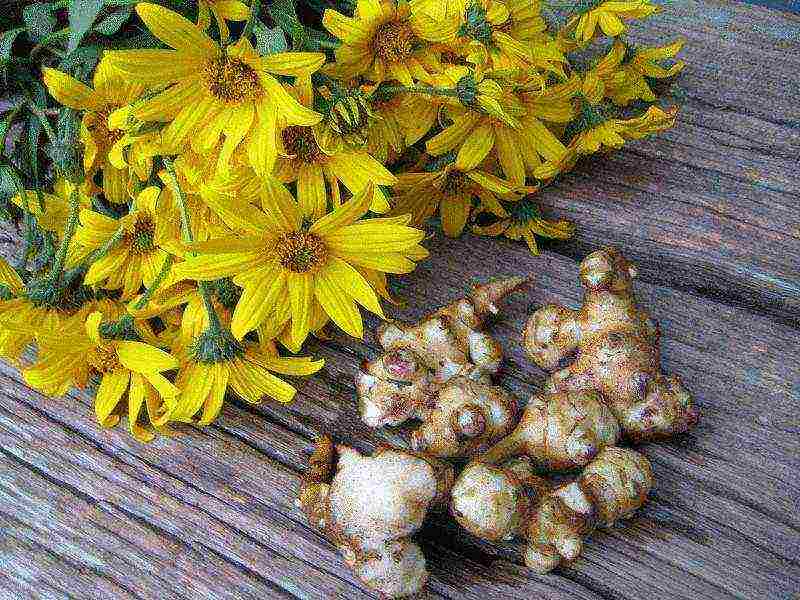
Many have heard of such a plant as Jerusalem artichoke. But few people know what amazing possibilities this plant has. If you start growing it, then you will forever give up potatoes, unless you are an avid fan of them.
Now people are trying to minimize their efforts to grow potatoes, they do not plow the soil, do not huddle, mulch, which does not require watering, many do not collect the Colorado potato beetle. But still, some effort must be made in order to grow it. What needs to be done, at least:
1. Potatoes need to be planted
2. It needs to be dug
3. In winter, you need to store it somewhere.
4. Mulch
And if you take the traditional method of growing potatoes, then this is a colossal labor input, which if you do not commit, then you will not get a harvest at all.
And what efforts need to be made to harvest Jerusalem artichoke from year to year? So, let's list them:
1. None !!!!
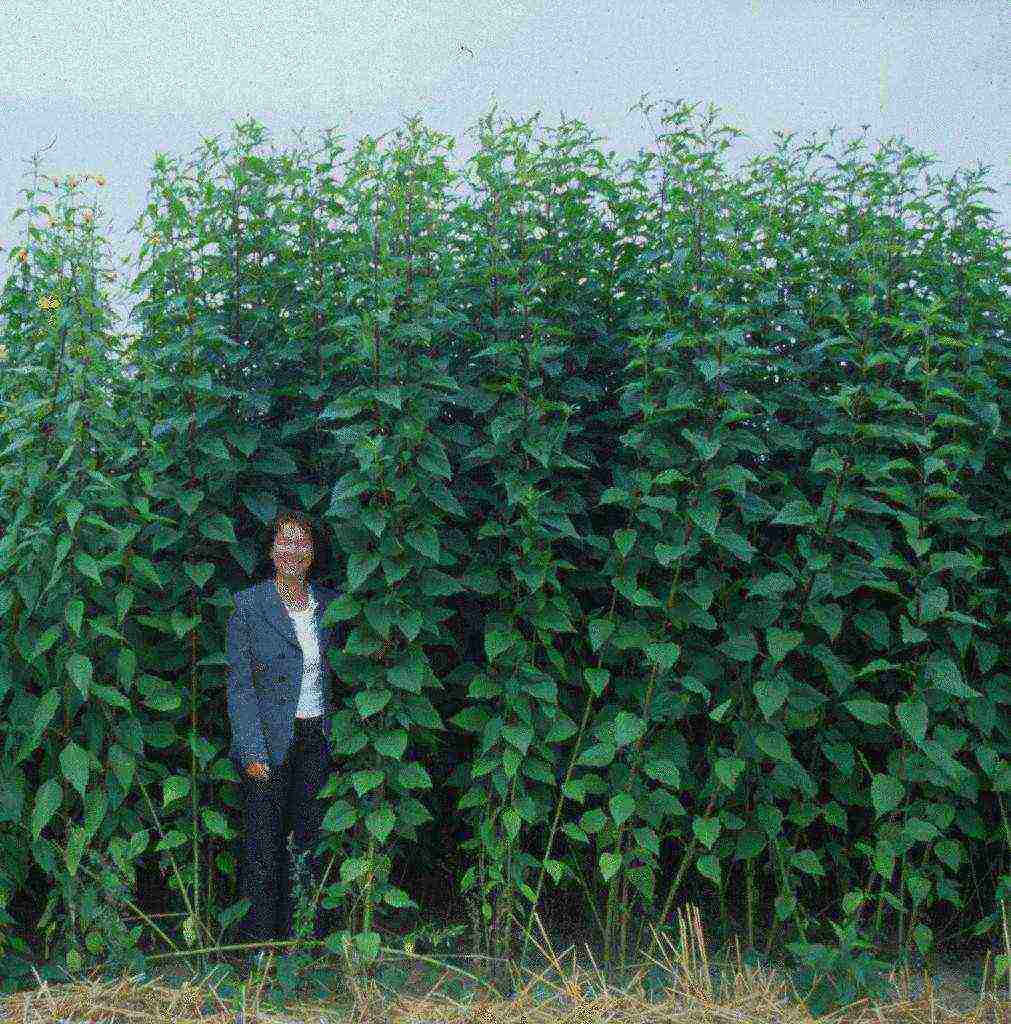
On the contrary, if you plant it once, then you will need to make great efforts to get rid of it. Of course, there is one action that needs to be done at the very beginning - it needs to be planted once and then it will grow with you from year to year. If you are lazy, then you can not even dig it out, it is perfectly stored in the soil in winter, so you do not need to build any storage for it. In this sense, Jerusalem artichoke is like a strong weed, and even if you dig it all out, it is even better for him - you will loosen the soil for him.
The Jerusalem artichoke tubers taste a little sweet, so it can be eaten even raw, unlike potatoes. And how many wonderful dishes are prepared from it - you can be convinced of this by typing in a search engine. In addition, Jerusalem artichoke can be used for medicinal purposes !!! And this despite the fact that this is a very beautiful, tall flowering plant.
Now many people are studying how to get a harvest without watering, weeding, etc. and whoever tries it in practice, rarely anyone succeeds the first time, then my advice is to start with Jerusalem artichoke and you definitely won't be mistaken.
When you have the opportunity to see this in practice, then such thoughts begin to come to mind: "Why do we need potatoes after that?"
Jerusalem artichoke is a common plant in Russia, which is usually perceived by ordinary summer residents as a malicious weed. These are beautiful yellow flowers, which, as it turns out, are almost impossible to remove, and people have to struggle with thickets for years.
In addition to flowers, Jerusalem artichoke is known for its tubers, which are popularly called an earthen pear. The claws are small - the size of a medium potato, in structure and taste - sweetish, juicy potatoes with a flavor of nuts and the aroma of sunflower seeds (this is one of the species of the genus sunflower). It is a valuable vegetable that can be eaten raw, cooked, made into syrup, and more. For us, this is the ideal culture: tasty, edible, tenacious, grows on its own.
Jerusalem artichoke is a beautiful plant, bees like it (one of the latest honey plants), rodents like tubers - they eat it instead of other, more valuable crops, it creates wind protection. We are actively propagating it on our site. For example, we plant on the sides of the rows of our forest field.
After several hours of drying, we get flowers that can be stored as long as you like, brewed in winter and enjoy the bright summer aroma.
Another academician Kliment Arkadyevich Timiryazev pointed to Jerusalem artichoke as "one of the most intensive field crops" and noted that the consumption of solar energy for the formation of organic matter (in parts) is 1/180 for him, while for rye, oats (grain , straw, root residues) - 1/80.
One hectare of Jerusalem artichoke is capable of absorbing 6 tons of carbon dioxide from the air per year, and 1 hectare of forest - 3-4 tons.If 1 hectare of forest can provide oxygen concentration sufficient for breathing of 30 people, then Jerusalem artichoke is 1.5 - 2 times more. In this regard, and also taking into account the resistance to acid rain, it is considered advisable to include Jerusalem artichoke in green spaces around industrial cities with strong air pollution.
Plants tolerate (withstand) an increased content of oxides of sulfur, nitrogen, hydrogen sulfide, ammonia and other gases and cleanse the air well from them.
After the disaster that occurred at the Chernobyl nuclear power plant, scientists made measurements for the presence of radiation in crops grown in the vicinity of the ill-fated place. It would seem that the results were obvious, but one fact became the reason for their sincere surprise: Jerusalem artichoke turned out to be absolutely usable. Surprisingly, it remains "clean" in relation to other contaminants present in the soil today. Add here its unpretentiousness, inversely proportional to its benefits, and you will understand how valuable this culture is.
Jerusalem artichoke has many names: "earthen pear", "Jerusalem artichoke", "sun root". Another name for Jerusalem artichoke is tuberous sunflower, because these plants are of the same genus. The plant received all these names over many centuries of use. Ancestors appreciated it for its taste and healing properties, but we underestimate it. Apparently because we know too little.
Jerusalem artichoke tubers have a very intricate shape of fusiform, pear-shaped, round, oval, etc. Jerusalem artichoke inflorescence is a sunflower in miniature - a basket. The appearance is not devoid of decorative merits.
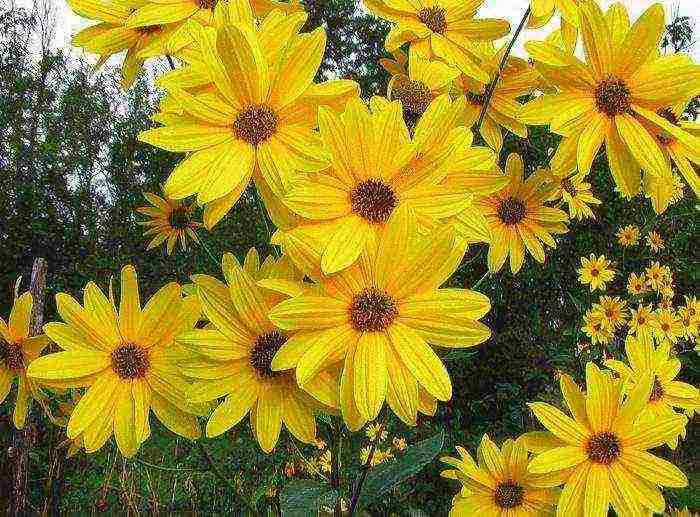
Jerusalem artichoke flowers
The homeland of the plant is America, where it grows wild. In the sixteenth century, the earthen pear was brought to England, later it came to France, where it got its traditional name "Jerusalem artichoke" (from the name of the Tupinamba tribe). The solar root came to Russia in the nineteenth century. I fell in love, and cookbooks began to be filled with many recipes for dishes from unusual tubers.
Useful properties of Jerusalem artichoke
The very fact that Jerusalem artichoke is not susceptible to various pollutants and remains, as they say, an environmentally friendly product, already makes it unusually useful. But he is able to transfer this property to us. Regular use of Jerusalem artichoke promotes deep cleansing of the body, getting rid of toxins, heavy metals and other nasty things that inevitably accumulate in urban life. Jerusalem artichoke contains pictin, which is a good absorbent and the reason for the very, wonderful, ability to cleanse the body. By the way, thanks to him, you can get molasses from Jerusalem artichoke and make wonderful jam (by the way, dietary jam, but more on that below). Here is such a roofing felts roofing felts fruit!
Removing "slags" from the body, this root replenishes it with other more useful and necessary substances, mineral salts (potassium, silicon, zinc, iron), pectins, amino acids, proteins and a large amount of vitamins (B1, B2, B6, C, PP). The content of polysaccharides makes it quite energy-intensive. Depending on the timing of harvest, the sugar content in the tubers may vary. The minimum indicator of this substance is noted in early October (eight percent), the maximum - in early December (up to twenty percent). Sugar accumulates in tubers due to the outflow of nutrients from the leaves and stems.
There is evidence that regular consumption of this root vegetable over a long period of time lowers the concentration of sugar in the blood. This is due to another wonderful element that is present in Jerusalem artichoke - inulin. Inulin is a polysaccharide, a source of energy, but its peculiarity is that its processing by the body is not associated with an increased release of glucose, as is the case with carbohydrates contained, for example, in other root vegetables, therefore, there is no risk of diabetes mellitus. There is good news for diabetics too. During storage of Jerusalem artichoke, inulin is converted into fructose, and the root vegetable fits perfectly into their diet. Remember the delicious Jerusalem artichoke jam? Eat it, drink Jerusalem artichoke compote and all this without characteristic consequences.
Studies accompanied by experiments have shown a significant positive effect of Jerusalem artichoke on the digestive system. With food and during digestion, a huge amount of ballast compounds enter the intestines, which are bound and neutralized. At the same time, the condition of the gastrointestinal tract improves, choleretic activity is stimulated.
The use of Jerusalem artichoke helps to strengthen the body's immune system, increase resistance to various kinds of viruses and infections that affect the digestive system. The beneficial substances of this vegetable prevent the penetration of various parasites and bacteria, for example, opisthorchis, into the body. In addition, Jerusalem artichoke contributes to the formation of normal intestinal microflora, creating all the necessary conditions for this. That is why this product is indispensable for people suffering from dysbiosis. Jerusalem artichoke improves blood flow to the mucous membranes, it is used in the treatment of stomach ulcers, duodenitis, enteritis, gastritis, pancreatitis, to eliminate heartburn, constipation and diarrhea.
Also, this fruit can be used to stop vomiting, relieve nausea, get rid of a bitter taste in the mouth, eliminate bloating and pain. With the combined use of Jerusalem artichoke and various medicines, the treatment period is reduced by five to seven days.
Also, the root vegetable promotes the early assimilation of selenium, despite the fact that this trace element is not present in its composition.
There is also a benefit in the ground part of Jerusalem artichoke. It is usually used to feed livestock, but the stalks can be pressed into a sweet juice suitable for making molasses. The fodder varieties of this plant are characterized by a small number of tubers and the presence of a dense green mass. If you feed cows with Jerusalem artichoke, then they noticeably increase milk yield, while the fat content of milk increases. When feeding chickens with this vegetable, egg production increases, the period of onset of egg production is reduced by two to three weeks. Also, Jerusalem artichoke is fed to goats, pigs, sheep and rabbits. This feed is especially valuable in early spring, because it contains a significant amount of vitamins and nutrients.
Growing
The ground pear is mainly propagated by tubers. In central Russia, as well as in the north, its seeds do not ripen. In one place, this plant can grow for more than forty years! In autumn, the ground part of Jerusalem artichoke dies off, in the spring the tubers remaining in the soil sprout, and the plant repeats its cycle of development and growth again. Its roots penetrate deeply into the soil, which contributes to high drought resistance. Tubers are usually replaced close to the surface, their weight rarely exceeds one hundred and twenty grams.
Earthen pear is grown in the same way as potatoes. Starting with the appearance of green shoots, it is covered with earth, which has a beneficial effect on the harvest. Jerusalem artichoke can be planted in winter or early spring. Before winter, it is necessary to plant only whole tubers, cut ones can rot. When planting in spring, cutting tubers is allowed, while it is important not to damage the eyes - growth buds. The plant prefers sunny places.
Jerusalem artichoke has an interesting feature: it can be harvested in autumn and spring. Tubers that are not dug out are perfectly preserved under the snow. They can repeatedly experience a thaw, freeze again during cold weather, and their vitality and nutritional value does not suffer in any way. Moreover! It has already been said that
If you need to plant other crops in the place where Jerusalem artichoke grew, then you must carefully collect all the tubers remaining in the ground.
How to store Jerusalem artichoke?
In the basement, an earthen pear must be stored at a temperature of zero degrees Celsius. Root vegetables quickly wither and dry in ordinary household conditions, while they become unusable.
Spring digging of tubers is preferable to autumn digging. As soon as the snow melts and the ground thaws, you can already start choosing an earthen pear. At a time when there are practically no vitamins in fruits and vegetables, they are fully preserved in it.
published
Jerusalem artichoke (earthen pear) is a well-known root vegetable, the benefits and taste of which were appreciated by the inhabitants of the planet several centuries ago. Containing a large number of vitamins, organic acids and minerals, Jerusalem artichoke is a perennial plant. Its tubers are widely used. Tuberous sunflower (this is how Jerusalem artichoke is called) belongs to the Asteraceae family and is a close relative of sunflower, only perennial. Cultivation of Jerusalem artichoke is an occupation that does not require the use of special knowledge and the application of laborious efforts.
External characteristics
Under favorable conditions, a herbaceous plant Jerusalem artichoke, which has large simple leaves, can reach a height of 3 meters. Its inflorescences are baskets with bright yellow flowers, 4-8 cm in diameter. Fruits are the same as those of a sunflower - achenes. The plant is completely pubescent, blooms from August to November, depending on the place of growth. In some regions, it does not have time to bloom due to insufficient daylight hours. The stalk of Jerusalem artichoke dies off for the winter, and with the onset of spring new shoots grow from the tubers.
Jerusalem artichoke tubers, the formation of which occurs identically to potatoes, have the shape of a pear, apple or spindle, the color of a thin skin, which requires careful handling of the product, varies from yellowish to pink, while the pulp is white. Jerusalem artichoke (the photo conveys its similarity to sunflower) is characterized by growth activity and unpretentious cultivation; the tuber, tasty and with medicinal properties, can winter in the ground, because it can withstand even 30-degree frosts.
In some cases, the plant is even able to displace neighboring crops, forming powerful shoots.
Jerusalem artichoke in history
The homeland of Jerusalem artichoke is North and Central America, where since pre-Columbian times this culture has been eaten by local Indians. In 1610, being a completely unknown tuber, Jerusalem artichoke, along with turnip and turnip, saved Europeans from starvation and thereby helped them survive. In England, he received another name - Jerusalem artichoke.
Previously, Jerusalem artichoke, the tubers of which outwardly resemble ginger root, was cultivated as a fodder and food crop, but over time it became fashionable and was eaten as a delicacy until the appearance of potatoes - a more fruitful and neutral in taste culture.
Nevertheless, Jerusalem artichoke, the photo of the tubers of which are presented above, is grown in almost all corners of the planet and is a tasty and healthy addition to the diet.
Growing Jerusalem artichoke
How to grow Jerusalem artichoke on your own plot? This culture is easy to grow due to its undemandingness to certain conditions. It is advisable for her to choose a sunny fertile area with loose soil (except for salt marshes and heavy soils), which determines the successful formation of tubers. Planting should be done in the spring or autumn, maintaining a row spacing of 60-80 cm, the interval between crops should not be less than 30 cm. Jerusalem artichoke, consumer reviews of the useful qualities of which indicate the possibility of using it for medicinal purposes, is planted to a depth of 10 -12 cm. Potato planting machines are used for this on an industrial scale. You should select even small tubers about the size of a chicken egg.
Care features
Caring for Jerusalem artichoke is simple, it is important to remove weeds from its growing territory in a timely manner so that a crop that can grow in one place for several years develops well.Over time, the plant itself will "crush" closely growing competitors, but at the first stage it should be helped, especially in the fight against wheatgrass and thistle. In the first weeks after planting, it is required to loosen the soil to ensure proper aeration. When the seedlings reach a height of 40-50 cm, it is recommended to spud the plants, with a meter growth - to tie them up. Since it is almost impossible to install a support under each stem, it is almost impossible to use wire supports with wooden or metal stands-bases.
Cultivation of Jerusalem artichoke is an easy task, even an amateur inexperienced in gardening can do it. During the flowering period, to increase yields, you should spud the plant and fertilize it with organic preparations.
The plant forms a large biomass. Some foreign scientists recommend periodically breaking off flowers in order to increase the yield of tubers. This will cause a greater supply of nutrients to the tubers of the plant.
Collection and storage of Jerusalem artichoke
The period of tuber growth lasts from July to September, the average yield from one square meter is 2-3 kg of fruits. The tubers should be dug up in the fall, winter and spring as needed. In addition, the soil is the most comfortable and convenient place for storing an earthen pear. In terms of storage quality, Jerusalem artichoke is an order of magnitude inferior to potatoes. In any case, it should be removed completely with the onset of heat, otherwise the plant will very quickly give growth, having conquered the adjacent territories.
Jerusalem artichoke, the seeds of which are its tubers, is recommended to be propagated in spring or autumn. To do this, the tubers can be used in whole or in parts, each of which should have 2-3 buds.
Pests and diseases
Like any plant, Jerusalem artichoke is exposed to the invasion of pests and diseases. So, periodically, the plant is overcome by Alternaria and powdery mildew. The nature of their defeat is not critical, but the struggle consists in the destruction of damaged parts of the plant or its transplantation to a new place.
Sometimes an earthen pear is overcome by white rot, which forms a white moldy coating on the stems of the plant, which, in addition, becomes covered with black growths from the inside, which leads to the death of the plant.
The enemies of Jerusalem artichoke are slugs, which seriously damage the tubers of the plant, eating them from the inside. Jerusalem artichoke is also to the taste of the numerous larvae living in the soil. The fight against such intruders is the use of anti-slug drugs and diazon.
Information for thought
So, the most interesting and memorable information about Jerusalem artichoke:
- able to grow in one place for more than 40 years, without causing damage to either the soil or the site;
- frost-resistant, tubers can withstand 30-degree frosts, green aboveground mass - no more than -5 degrees;
- the average yield of an adult bush is about 2 buckets of tubers, after the fifth year of planting, yields will decrease;
- planting is done by tubers according to the principle of planting ordinary potatoes;
- in the middle of the summer season, it is recommended to prune the bushes, leaving no more than 1.5 m of the aboveground part;
- with the onset of autumn cold weather, the stems of the plant should be harvested, leaving only 20-30 cm of the aboveground part (during this period, you can start harvesting).
Jerusalem artichoke cultivation is aimed both at own needs and at the formation of feed stock for pets. Jerusalem artichoke has found its application in folk medicine, being an effective remedy against various ailments. It is a source of inulin (an analogue of insulin), which is converted to fructose during storage and gives the root vegetable sweetness, as well as an excellent supplier of iron and dietary fiber, containing a high percentage of potassium, vitamins and essential amino acids.
Taste characteristics of Jerusalem artichoke
Growing Jerusalem artichoke does not take much time, but the result is always evident. Raw Jerusalem artichoke is sweetish and tastes like a nut.Its raw tubers are used in desserts, fresh salads, boiled, steamed, fried, baked and dried. The heat treatment gives the Jerusalem artichoke a rich flavor that partially resembles mushrooms. It is prepared in the same way as potatoes. A root vegetable that does not lose its useful properties for a long time can be dried and ground into flour. This culture is used in marinades and pickles. In Germany, a delicious beer is prepared on the basis of Jerusalem artichoke.
Before use, it is recommended to rinse the Jerusalem artichoke in the sink to remove any residual soil. It is not required to peel off the peel from root crops; it contains many useful substances. The remaining roots, damaged areas, the upper and lower parts should be carefully cut from the tubers.
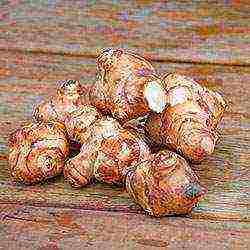 Many people have heard of Jerusalem artichoke. The cultivation of varieties of this partly edible, partly medicinal, partly decorative culture in Russia has been engaged in for quite a long time. When propagating, the vegetative parts of the plant are used. Planting and care, as well as harvesting of mature crops, have a number of features.
Many people have heard of Jerusalem artichoke. The cultivation of varieties of this partly edible, partly medicinal, partly decorative culture in Russia has been engaged in for quite a long time. When propagating, the vegetative parts of the plant are used. Planting and care, as well as harvesting of mature crops, have a number of features.
Description: varieties and varieties of Jerusalem artichoke
In Russia, the cultivation of perennials is practiced by a few summer residents. But there are countries where the culture is produced on an industrial scale. In Asia and the American continent, the plant is in demand for food. In addition, Jerusalem artichoke has a powerful complex of trace elements and vitamins. Key characteristics of the plant:
- possesses a powerful branched rhizome; edible tubers grow on its underground stolons. Outwardly, they look like ginger root;
- the color of the tubers is white, yellow, red or purple, depending on the variety;
- their taste resembles a turnip or stump;
- stem erect at the bottom and branched to the apex, 0.4-3 m high, strong, slightly pubescent;
- leaves - large, ovoid, with a pointed tip and a carved edge;
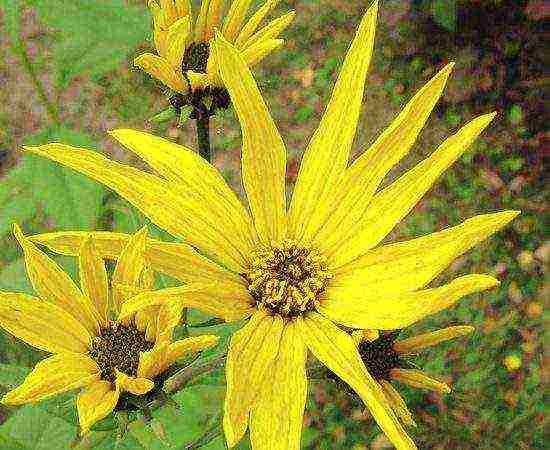
Jerusalem artichoke flowering
- flower shape - a basket of middle tubular flowers, diameter - 10-15 cm.
- the color of the flowers is golden yellow.
Attention! Jerusalem artichoke blooms in mid-summer. By August, the plant forms ripe seeds.
The varieties of this culture are divided into tuberous and fodder. The latter give a good indicator of green mass. The crop is used as livestock feed. These varieties are cultivated on an industrial scale. Early and late-ripening tuber Jerusalem artichoke is grown on individual farms for the sake of healthy and tasty root crops. Their average yield is about 2 buckets of tubers from a bush.
There are a lot of popular tuberous varieties of earthen pear:
- Interest;
- White;
- Red;
- Leningradsky;
- Early ripening;
- Vadim;
- Solar;
- North Caucasian;
- Volzhsky 2;
- Pasko;
- Find;
- Patat;
- Omsk white.
Advice. You can choose the right one based on the photo of the appearance, as well as on the specific characteristics of the tubers and recommendations for caring for them.
Tuberous sunflower: planting a plant
For planting Jerusalem artichoke in the southern regions, they choose late autumn, in the north - the border of April and May, planning work simultaneously with planting potatoes. Use tubers harvested for propagation. The culture develops normally in neutral or slightly alkaline soil of any type, except for heavy soils and saline soils. A prerequisite for the correct reproduction of Jerusalem artichoke is its planting in fertile soil.
Advice. In the fall, apply organic fertilizers for digging - manure or compost. For winter planting, this must be done in 2-3 weeks. It is not necessary to break up large lumps of earth at this stage, you will have time in the spring.
Find a place on the site that is sufficiently well lit by the sun. Dig trenches up to 15 cm deep for planting. The distance between the nests is at least 35-40 cm. After deepening, close the ditch with a rake so that a small earthen ridge is formed above it. Row spacing 70 cm. Water minimum.
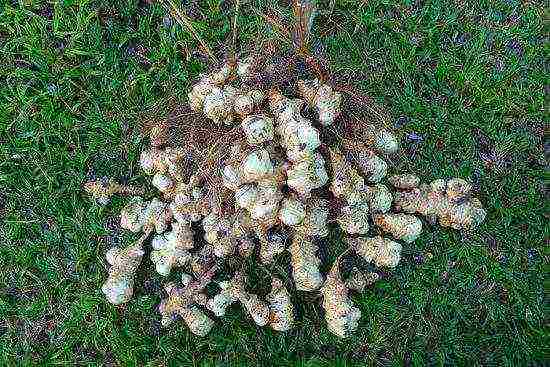
Jerusalem artichoke root tubers
Jerusalem artichoke care
The earthen pear belongs to those crops that are extremely undemanding to care in the open field. But by paying attention to it, you will increase the yield. The main aspects of caring for Jerusalem artichoke:
- In the early stages of growth, Jerusalem artichoke roots need oxygen. Therefore, loosen the space around the garden bed. The more often the better. When shoots appear (15-25 days), use the hoe more carefully.
- Remove weeds from the beds and row spacings until the plant is strong.
- When the earthen pear reaches a height of 40-50 cm, carry out hilling.
- After the bush reaches a height of 0.8-1 m, it will need support. It is effective to use a wire stretched between the posts for this.
- To channel the forces of the plant during the flowering period into the development of tubers, it will need such care measures as re-hilling and pruning of flowers.
- Watering. In the season with the usual rainfall, you don't have to worry about wetting the garden. The plant needs watering only during prolonged drought.
- In July, prune the bushes to a height of 1.5 m.
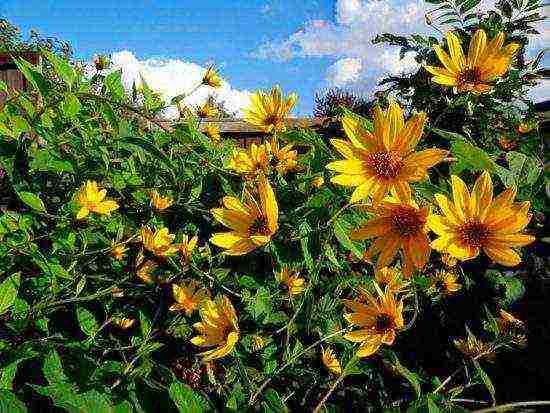
An earthen pear does not require careful maintenance
Outdoor tubers ripen approximately 120 days after germination. Pre-cut the stems to 20-30 cm. In the case of Jerusalem artichoke, it is better to overexpose the crop than underexpose it in the ground. Therefore, it can be collected not only in October-November, but also left in the ground until March-April. Root crops will perfectly tolerate frosts down to -40 ° C, if the winter is snowy or add a little soil to the garden.
Advice. Harvesting at different times will save you the effort of organizing storage. In the spring, it is important to hold it before the massive warming. Otherwise, the tubers will sprout and grow over the site.
Fertilizing and feeding Jerusalem artichoke. Plant propagation
For normal cultivation in open ground, young bushes need phosphorus and potassium. Apply mineral fertilizers with a combination of these substances at the planting stage. During the flowering period, top dressing will help the culture to form the highest quality tubers. Gardeners apply organic fertilizers such as green manure or seaweed mixtures.
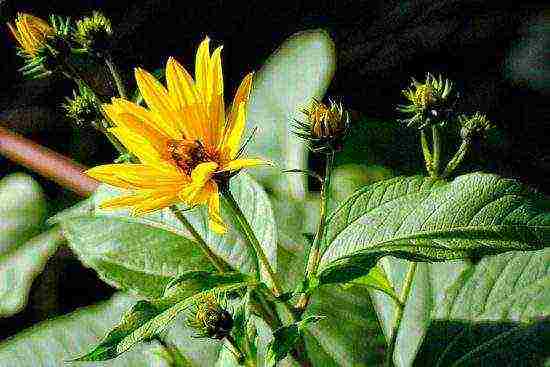
Fertilizer must be applied to the soil at the stage of planting.
Reproduction of earthen pear occurs only by tubers, like potatoes. They should be left intact when grown in winter or cut into pieces for spring work. Planting material about the size of a chicken egg emerges best. The contour and surface of the tubers must be even, without visible defects or damage.
Attention! Jerusalem artichoke propagation is possible with the help of seeds. However, it is used only by breeders with the necessary knowledge and laboratory conditions.
Diseases and pests of Jerusalem artichoke. Combination with other plants on the site
The earthen pear is a strong and tenacious plant in open field conditions. Therefore, pests and harmful microorganisms usually do not touch the plant if the care and conditions of its maintenance are in accordance with the standards. You can identify those who spoil the crop by looking at the photo. Most often, Jerusalem artichoke affects:
- Slugs and all kinds of larvae. They feed on tubers, leaving characteristic grooves and holes on them. To combat these pests, use Diazon or anti-slug pellets that are sold in specialty stores. You can also try folk remedies.
- White rot. Outwardly, it manifests itself as white mold on the stem. Inside, the green mass is covered with dark growths. Fighting rot is pointless. Simply remove and burn the infected plants.
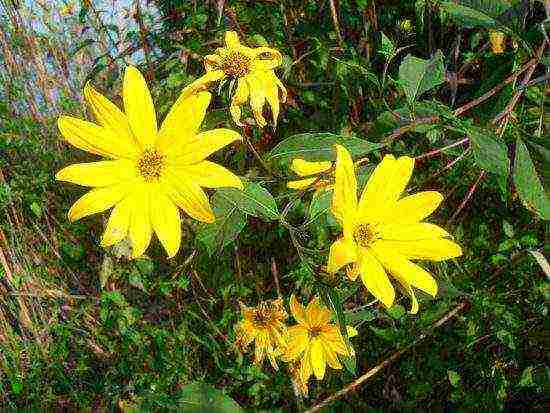
Pests and diseases rarely affect Jerusalem artichoke.
Quite often, Jerusalem artichoke ailments are difficult to recognize. The reason to take a closer look at the plant may be wilting or a change in the shade of greenery.
An earthen pear is sometimes used on the site and for decorative purposes. If you don't pick flowers in the summer, you will get a flower garden from sunflower-like buds. Plants also look beautiful when cut in bouquets.In addition, green Jerusalem artichoke thickets look good in combination with tall varieties of asters or chrysanthemums. In general, with this culture, you can create various scenic compositions with many autumn colors.
Growing Jerusalem artichoke: video
Jerusalem artichoke cultivation in Russia
Jerusalem artichoke, according to our estimate, is cultivated on an industrial scale in the Russian Federation on an area of more than 2 thousand hectares. These are Nizhny Novgorod, Tver, Ryazan, Tula, Ulyanovsk, Kostroma, Volgograd, Omsk, Bryansk, Moscow, Saratov, Yaroslavl regions, Chuvashia, Krasnodar, Stavropol Territories, etc. In Maikop there is a collection of VIR, numbering more than 300 varieties. VNIIKH is investigating 18 promising varieties and hybrids. The main problem that restrains the spread of Jerusalem artichoke is that the demand for this valuable crop, which is a source of inulin, fructose and pectin, has not been formed. Currently, there is investment in the construction of enterprises for processing Jerusalem artichoke into inulin, but the lack of raw materials on an industrial scale and the absence on the market of a complex of machines for mechanized Jerusalem artichoke cultivation jeopardize the implementation of these investment projects. The demand for inulin, according to the profile institutes of the Russian Academy of Agricultural Sciences, is more than 20 thousand tons. The cost of production of inulin from Jerusalem artichoke is about 30 rubles / kg, the price of an imported one is more than 160 rubles / kg. Due to the lack of domestic inulin, enterprises producing baby food containing probiotics are completely dependent on imports.
Table. Areas of industrial cultivation of Jerusalem artichoke.
| Region, region | Jerusalem artichoke cultivation area, ha |
| Adygea | 0,3 |
| Bryansk region | 0,1 |
| Volgograd region | 0,1 |
| Kostroma region | 0,1 |
| Krasnodar region | 0,3 |
| Kirov region | 0,1 |
| Moscow region | 0,1 |
| Nizhny Novgorod region. | 0,2 |
| Chuvash Republic | 0,1 |
| Ryazan region | 0,1 |
| Stavropol region | 0,3 |
| Tver region | 0,1 |
| Tula region | 0,05 |
| Yaroslavl region | 0,05 |
At the international congress "Inulin and Inulin-Containing Plants", held in Shanghai in 2010, along with many countries of the world, representatives of Russia were present. Among the main areas of work, the congress noted the need for extensive processing of Jerusalem artichoke to obtain inulin, fructose syrups, new sugar substances, sweeteners, alcohol (ethanol), fodder yeast, as well as high biological value products for use in the food, medical industry and agriculture. ...
One of the promising areas is new areas of use of inulin from Jerusalem artichoke. In the Netherlands and Germany, effective methods have been developed for the production of hydroxymethylfurfural (HMF) and its derivatives from inulin. The structure of HMP presents extremely great opportunities for chemical synthesis and transformation in order to obtain a variety of drugs, paints, semiconductors, photoconductors, photochromic and other materials for optoelectronics. There are prospects for obtaining aromatizing compounds, liquid crystals, and corrosion inhibitors from HMF. We do not have such technologies yet.
Jerusalem artichoke and Jerusalem artichoke, as a raw material for feed production, will improve the structure of the produced feed, increase their protein and energy nutritional value, greening feed production while saving all types of resources and costs due to the large-scale development of scientific achievements. In recent years, the share of corn in the compound feed formulation has significantly decreased and the share of other types of grain (barley, oats, rye) has increased, the inclusion of which significantly increases the content of difficult hydrolysable and inhibiting substances in the compound feed, disrupting digestion processes, reducing the productivity of animals and increasing feed costs.The introduction of inulin and bioethanol production wastes into the composition of feedstuffs provides an increase in the economic efficiency of animal husbandry and guarantees the environmental safety of animal products. New feeds are especially effective for young cattle, pigs, pond fish farming, as well as for raising young fur animals (mink, arctic fox, nutria, etc.).
Thus, the problem of providing the population with domestic mass food products, and animal husbandry with fodder includes an important direction in the development of Jerusalem artichoke production.
Intended goals and objectives
The development of Jerusalem artichoke production is an important strategic task as a crop with the highest food, energy and fodder yield per unit area.
To solve this problem, it is necessary to highlight the following goals:
- to develop a technology for industrial production and processing of Jerusalem artichoke, to form a market for the production of healthy food, feed and bioethanol from Jerusalem artichoke.
To achieve these goals, it is necessary to solve the following main tasks:
To develop and implement scientifically grounded seed-growing schemes and modern technological regulations for the rapid reproduction of the original, elite and reproductive seed Jerusalem artichoke;
Develop and implement a modern system of quality assurance and certification of Jerusalem artichoke seed;
To develop and introduce effective technologies for the cultivation and storage of Jerusalem artichoke;
To develop and introduce an innovative complex of agricultural machinery for the cultivation and harvesting of Jerusalem artichoke, effective in various climatic conditions;
To develop highly efficient waste-free resource-saving technologies for obtaining food products and inulin using the latest achievements of the nanoindustry (nanographite bactericidal filters and media concentrators and using membrane filtration);
To develop a recipe and industrial technology for the production of functional and ecological multicomponent healthy food products of a new generation from Jerusalem artichoke;
Develop a technology and organize the production of food inulin,
To develop industrial technology and equipment for the production of bioethanol and Jerusalem artichoke feed.
List of planned main activities
In solving the problem of increasing competitiveness, the need to establish seed production is especially relevant.
The network of regional basic enterprises for original (primary) seed production should ensure the annual production of tubers of guaranteed quality of the best varieties in the volume of production needs.
The main measures for the development of Jerusalem artichoke seed production in Russia:
Formation of a regional network of institutions and agricultural organizations that perform the functions of basic centers for the original (primary) seed production of Jerusalem artichoke using innovative micropropagation technologies.
Equipping laboratories for clonal micropropagation with modern laboratory equipment, devices for diagnosing phytopathogens by ELISA and PCR methods, express analysis, as well as sets of field equipment for primary nurseries
Modernization of the storage base using modern equipment, technology and effective climate control systems
The accelerated methods of reproduction proposed in the Concept of the Program allow within 3 years to reach the volume of industrial cultivation that meets the production requirements.
The list of measures to achieve this goal:
Organize a bank of healthy varieties of Jerusalem artichoke for industrial production;
To develop, conduct a production check and recommend to production innovative technologies for the rapid multiplication of high-quality Jerusalem artichoke seeds;
To develop, conduct a production check and recommend to production efficient resource-, moisture-saving, drought-resistant bed technologies for the cultivation of Jerusalem artichoke;
To develop, conduct a production check and recommend to production efficient resource-saving storage technologies for Jerusalem artichoke;
To develop, conduct a production check and recommend to production an effective complex of agricultural machinery for the cultivation and harvesting of Jerusalem artichoke;
To develop, conduct a production check and recommend to production highly efficient technologies for obtaining food products, inulin, bioethanol and feed.
Jerusalem artichoke, or Jerusalem artichoke, or Tuberous sunflower (Latin Heliánthus tuberósus) is a type of tuberous plants of the genus Sunflower of the Astrov family. The plant is also known as "earthen pear" and "Jerusalem artichoke". The tubers are edible. It is cultivated as a valuable fodder, industrial and food plant.
Jerusalem artichoke is a perennial herb with a height of 40 cm to two meters with an erect branching stem, pubescent with short hairs and underground shoots on which tubers develop.
The leaves are serrate-toothed petiolate: the lower ones are ovoid or heart-ovate, opposite; the upper ones are elongated-ovate or lanceolate, alternate.
The flowers are collected in inflorescences of a basket with a diameter of 2-10 cm. The median tubular flowers are yellow, bisexual; marginal sterile pseudo-ligate flowers are golden yellow, from ten to fifteen. Blossoming in the European part of Russia in August - October.
The fruit is an achene, in the European part of Russia it ripens in September - October.
Chemical composition and nutritional value
In terms of chemical composition, Jerusalem artichoke tubers are akin to potatoes. In terms of nutritional value, they are superior to many vegetables and twice as valuable as fodder beets.
Jerusalem artichoke tubers contain up to 3% protein, mineral salts, soluble polysaccharide inulin (from 16 to 18%), fructose, trace elements, 2-4% nitrogenous substances. Quite rich in vitamin B1, contain vitamin C, carotene.
The sugar content in tubers increases depending on the harvest time due to the outflow of nutrients from the stems and leaves.
Hybrids and varieties
More than 300 varieties and hybrids of Jerusalem artichoke are known in the world. Some are distinguished by a large yield of tubers, others - of green mass (with small tubers), others - by a special decorative effect, etc. In Russia, the most famous nowadays varieties of Jerusalem artichoke are 'Kiev White', 'Red', 'Fusiform', 'Patat', ' Maikopsky, Bely, Skorospelka, Nakhodka, Volzhsky 2, Vadim, Leningradsky, North Caucasian, Interest.
Only 2 varieties are cultivated industrially in Russia: Skorospelka and Interest. 'Skorospelka' is an early ripening variety that yields a crop of tubers by the end of September, which allows it to be cultivated in central Russia. The average yield for tubers is 25-30 tons per hectare, for green mass - 30-35 t / ha. ‘Interest’ is 1.5-2 times more productive than ‘Skorospelka’, but the tubers ripen only in November. Does not ripen in tubers in the middle lane. It is effectively grown only in the southern regions - from the Volgograd region and to the south for -146 days.
By crossing Jerusalem artichoke with sunflower, a new plant was created - Jerusalem artichoke. For the first time such a crossing was carried out in the USSR. At the Maikop experimental station of VIR, N.M. Pasko bred the ‘Vostorg’ (ZM-1-156) topin sunflower variety. The tubers of this variety are large, oval, with a smooth surface. The yield of tubers reaches 400 centners per hectare and more, green mass - 600 centners / ha.
Varietal variety
Jerusalem artichoke varieties are divided into tuberous (vegetable) and fodder. Forage crops give a higher yield of green mass and fewer tubers.In recent years, scientists and practitioners in Russia have bred more than 20 new varieties, the tubers of which are located in compact nests, which allows them to be removed from the soil almost completely. At the Maikop experimental station of VIR, a world collection of Jerusalem artichoke has been collected, representing a unique gene pool.
In connection with the increasing interest in Jerusalem artichoke as a crop for subsequent industrial processing, there is a need for varieties with certain technological characteristics, while they will be different in agro-climatic cultivation zones. Today the following varieties of Jerusalem artichoke are most popular: "Kievskiy white", "Red", "Veretenovidny", "Patat", "Maikopskiy", "Bely", "Early ripe", "Nakhodka", "Dieteticheskiy", "Volzhskiy-2" "," Vadim "," Leningradsky "," North Caucasian "," Interest ". By the way, the environment does not at all affect the quality of Jerusalem artichoke and the presence of nutrients in it. This is due to the fact that the tubers of the plant do not accumulate nitrates, and due to their unique chemical composition they are even able to convert them into safe compounds. In addition, Jerusalem artichoke is not at all afraid of heavy metals in the soil. This plant can be safely grown even in a metropolis and eaten without fear of any toxic substances.
Biochemical composition
Jerusalem artichoke contains a fairly large amount of dry matter - up to 20%, including up to 80% of the polymer homologue of fructose - inulin. Inulin is a polysaccharide, the hydrolysis of which leads to the production of a harmless sugar for diabetics - fructose. Jerusalem artichoke contains fiber and a rich set of minerals, including calcium, magnesium, sodium, manganese, and iron. Mineral substances perform versatile functions in the body: they provide the construction of supporting tissues of the skeleton (Ca, P, Mg, Si), maintain the necessary osmotic environment of blood cells, in which all metabolic processes (Na, K) take place, participate in the formation of digestive juices (Cl) , hormones (I, Zn, Cu, Se, Mn), oxygen carriers in the body. The rich composition of biologically active substances of Jerusalem artichoke makes this plant promising in terms of functional nutrition. The plant is also of interest as a starting material for the creation of highly effective drugs.
Agrotechnics
The territory of Russia has a wide variety of agro-climatic zones and each zone requires its own peculiarities of the agricultural technology of Jerusalem artichoke culture. But for all cases, several generally accepted conditions can be distinguished for obtaining guaranteed stable yields of Jerusalem artichoke. For this, the proposed area of Jerusalem artichoke must have a sufficiently high arable horizon, be light in texture, with a pH reaction close to neutral and without steep slopes.
Obtaining high yields of tubers and green mass is impossible (especially in the first years of the growing season), without the introduction of 100-200 t / ha of organic fertilizers or composts. Mineral fertilizers are recommended to be applied in the range of 60-100 kg. active ingredient per 1 hectare, taking into account the ratio of nitrogen, phosphorus and potassium, depending on the timing of application and their direction: more green mass or the quality of tubers. Soil preparation begins with autumn plowing with a plow with a skimmer, and then the soil is leveled and discarded. A cultivator with a hiller cut ridges at a distance of 70 cm. In the equilibrium period, as the soil thaws and the possibility of using agricultural implements. If necessary, the ridges are restored to a height of 18-22 cm.
Until now, in most regions of Russia, pests and plant diseases have not been observed on the plantings of Jerusalem artichoke, which makes it possible to completely exclude the use of pesticides.
To obtain good quality planting material (tubers), it is recommended to leave the green mass for the winter or harvest at the maximum cutting height and do not dig the tubers out of the soil. This is because the standard planting tuber is formed at the end of September. When the green mass freezes, nutrients are released into the tubers, which increases their average weight and improves quality. In this case, the tubers are harvested in spring and immediately used for planting.
In industrial volumes, the autumn period for planting Jerusalem artichoke has proven itself well, before the soil begins to freeze.
When using the sowing of this year to obtain silage and tubers for fodder, the green mass is harvested in the second half of September using traditional forage harvesting equipment. Harvesting of green mass is carried out at a high cut. Before the onset of persistent cold weather, before the soil freezes, tubers are harvested using potato diggers or potato harvesters. When using Jerusalem artichoke only in the form of green mass, mowing is carried out as needed. In this case, tubers are not dug out. In autumn or early spring, the area is plowed, followed by disking. After the appearance of green shoots from the tubers remaining in the soil, harrowing is carried out, at a plant height of 10-15 cm, bouquet is carried out with a row cultivator with pointed paws and simultaneous feeding with mineral fertilizers.
The use of Jerusalem artichoke for food, medical and technical purposes
Jerusalem artichoke is a culture of universal use. It is characterized by high energy, pharmacological and nutritional value.
For technical purposes, as an additive to gasoline, it is used to obtain ethyl alcohol in the USA, Canada, Brazil, France, Austria, Hungary.
Jerusalem artichoke stems can be of interest for the pulp industry, as well as for the production of briquettes for combustion as fuel. The remains of waste Jerusalem artichoke tubers (pomace), which are used as additives in biscuits and other products of the confectionery industry, are also valuable. Jerusalem artichoke can also be used in weight loss diets. The inulin contained in Jerusalem artichoke syrup, according to experts, causes a feeling of fullness, since the receptors responsible for irritating the appetite center of the human brain are blocked.
Jerusalem artichoke use in feed production
Due to the high content of dry substances, good carbohydrate and vitamin supply, as well as a small amount of fiber, the green mass of Jerusalem artichoke has significant feed advantages. In Siberian conditions, the nutritional value of 100 kg of green mass is 20-25 feed units. This is 1.5-2 times higher than the nutritional value of sunflower green mass. 1 kg of tubers contains 0.23-0.29 feed units.
The aboveground part of the plant and tubers provide 200-300 centners of feed units per hectare and 12-16 centners / ha of digestible protein. Jerusalem artichoke exceeds the output of feed units 2.9-7.9 times, and the digestible protein 1.6-5.9 times higher than corn, annual and perennial grasses, potatoes. For the conditions of Siberia, this factor becomes even more important, when in April-June stocks of succulent fodder run out and there is no fresh greenery, then tubers from storage or spring digging provide an excellent fodder base.
In terms of nutritional value, Jerusalem artichoke also surpasses flowering clover and corn. Animals eat vegetables more readily than other grasses, not only fresh, but also in the form of silage and haylage. At the same time, their weight gain and productivity are much higher than with conventional feeding. The green mass can be fed fresh to livestock. Jerusalem artichoke leaves have 2 times more protein than stems (especially in the period July-August).You can feed pigs exclusively with Jerusalem artichoke leaves (practice in Germany), to which partly meal and reverse are added.
Milk yield per cow of 300 kg with 4% milk fat is obtained by feeding silage from Jerusalem artichoke green mass. Green mass of multivitamin (carotene, ascorbic acid, riboflavin, nicotinic acid, etc.). Jerusalem artichoke tubers play a special role in cattle feeding. The inclusion of 10-15 kg of tubers in the diet of cows already on the 6th day increases milk yield by 4-5 kg per day, and feeding young animals with them significantly increases the weight gain. Tubers are most valuable in spring when there is a lack of vitamins. If sprouted potatoes contain solanine, which is harmful to the body, then Jerusalem artichoke tubers, on the contrary, in the spring contain biologically active substances and protein that stimulates the milk production of cows, ewes, sows and the egg production of chickens. Tubers are fed to poultry fresh, as well as steamed and silage.
Jerusalem artichoke is an irreplaceable crop in sheep breeding. Pig grazing on Jerusalem artichoke plantations allows you to almost completely exclude other types of feed from the diet. Feeding piglets' tubers increases weight gain by 20-30%, and fattening pigs improves fat. For winter feeding, combisilos are prepared from tubers (tubers + alfalfa flour 10%).
For green feeding, the plant is of great value in fur farming, where leaves and stems are willingly eaten by hares, marals and other wild animals, and tubers in autumn are well eaten by wild boars. In hunting farms in Siberia, Jerusalem artichoke is planted along the edge of forest areas, where, growing, it creates impenetrable thickets, which are not only a good food base for wild animals, but also serve as reliable protection against poachers.
The high nutritional value of Jerusalem artichoke allows it to be used in the form of silage as a good feed for all farm animals. The presence of a large amount of sugars in plant stems (up to 25-30% to dry matter) makes them easy to ensile. The moisture content of Jerusalem artichoke silage is in the range of 60-75%.
The green mass for silage is harvested in the 1st decade of September (depending on weather conditions) before the onset of frost. For less loss of green mass, it is advisable to use the KS-1.8 "Whirlwind" forage harvester (losses 1.3-2.7%) and KPI with a corn header. Silage is carried out in trenches. The choice of the type of trench is determined by local conditions, but its capacity must be at least 500 tons (width 6-9 meters). The laying technology is similar to that of corn. A good effect is obtained by adding grain to the laid mass of straw (up to 50%).
Jerusalem artichoke silage has less fiber and more digestible protein than corn and sunflower silage. As a rule, silage is of high quality; it accumulates up to 1.5% of lactic acid, which makes up at least 50% of the total amount of acids. In the process of ensiling, the pH drops to 3.9-4.2. Due to the high content of dry matter (25-30%), Jerusalem artichoke silage, unlike corn, is never over-acidified. Almost all nutrients and quite a lot of vitamins are stored in it. The carotene content reaches 30-50 mg per 1 kg of feed.
Jerusalem artichoke green mass silage is well stored and is readily eaten by animals after a short training period. 100 kg of silage contains 18-25 feed units and up to 2 kg of digestible protein, and the energy capacity of 1 kg of silage reaches 820 kcal. This is much higher than silage from other plants. Combined silage (Jerusalem artichoke + beet leaves + grass + corn stalks and leaves + concentrated feed) gives good results in animal feeding.
Green mass can serve as a good raw material for the preparation of grass meal. With the right technology, the best preservation of nutrients is ensured in herbal flour. For the preparation of 1 centner of grass flour, an average of 4-5 centners of green mass with a moisture content of 75% are consumed.In terms of nutritional value, herbal flour is not inferior to many grain concentrates and surpasses them in usefulness, protein, minerals and vitamins. Nutritional value of 1 kg of Jerusalem artichoke flour is about 0.7-0.9 feed unit, protein content - 16-25%, fiber - no more than 20%, carotene 60-130 mg / kg.
Biology and morphology
The study of morphological characters and the corresponding qualifications of Jerusalem artichoke were carried out at the Maikop experimental station of the VIR on a large collection of material. Here, for the first time, a detailed description of the main morphological variety-distinctive characters in Siberia was given. Significant differences between the regions of Siberia across the entire range of soil and climatic conditions from the conditions of the Krasnodar Territory will allow us to consider the possible variability of Jerusalem artichoke and the manifestation of this variability. In addition, certain dependences of morphological and some economic and biological characteristics are revealed. These observations, along with theoretical ones, acquire a practical character.
The height of the stem depends on the soil and climatic conditions. The thickness of the stem is measured during the flowering period or the maximum development of the main stem with a caliper at a height of 10 cm and varies from 18 mm to 43 mm. It is noticed that the thickest stems are in weakly bushy forms and vice versa. The toughness of the studied varieties is different and ranges from 1 to 8 stems. The number of stems depends on the shape of the tuber, its ability to form babies, nodules and protruding large buds. We have noted that wild and primitive forms have the greatest bushiness. Branching depends on the variety and feeding area; it was noted that branching is weak under unfavorable conditions. There are assumptions that Jerusalem artichoke has predominantly monopodial branching, going up the main stem, but there is also an opinion that some varieties combine monopodial and sympodial branching. Moreover, plants with shoots of sympodial branching are distinguished by early maturity.
Selection and seed production of Jerusalem artichoke
Jerusalem artichoke is cultivated and used for food, medicinal, technical, forage and environmental purposes.
Today, the Maikop Experimental Station VNIIR maintains and studies the world collection of Jerusalem artichoke, which represents a unique gene pool: 310 varieties, 59 interspecific hybrids, including 34 topisolines. The collection serves as a starting material in the selection aimed at improving the Jerusalem artichoke, taking into account the production requirements.
So, when using the developed method of growing plants in the field and acting with a short photoperiod, the flowering of late-ripening varieties accelerated up to 67 days, mid-ripening up to 57 days and unripe up to 36 days. This made it possible to study the morphological and biological characteristics of plants in the generative phase of development, to determine the fertility of pollen, the setting of achenes, and seed productivity. For the first time, there was an annual opportunity to collect seeds from collection varieties from free pollination and directed crosses for breeding and other purposes. We used the methods of simple (paired), backcrossing and complex crosses (with consistent over the years the attraction of hybrids obtained from paired crossing of various varieties).
Methods have been worked out: preparing seeds for sowing, growing seedlings in a greenhouse, and then in a field. Seed germination by combinations of interspecific crosses is 36-66%, and from interspecific crosses 47-75%. The legacy of traits by aboveground and underground organs of hybrid plants has been established. From crossing varieties with different types of tuberous nest, the tendency of the quantitative distribution of hybrids towards wild and primitive is manifested.
Agrotechnics
Jerusalem artichoke agrotechnics is simple and similar to potato agrotechnics.Jerusalem artichoke is undemanding to growing conditions, winter-hardy, grows in southern and central Russia to the latitude of St. Petersburg. In the conditions of Central Russia, it can die in severe winters, although in areas with a milder climate (for example, the Pskov region, northern regions of Tatarstan) it grows steadily.
Jerusalem artichoke and its hybrids are short-day plants, light-loving, tolerate temporary drought well and are considered very hardy crops.
Soils for Jerusalem artichoke are suitable for any, except for saline, strongly acidic and waterlogged. But the best are light loamy and sandy loam soils with a deep and cultivated arable layer and good moisture. Plants respond well to soil improvement with humus and mineral fertilizers.
Propagated mainly by tubers - seeds in the North and in central Russia do not ripen.
Planting in early spring to a depth of 6-12 cm (in autumn - 10-12 cm), in rows after 60-70 cm and 40-50 cm in rows. They are usually planted in specially designated areas (hatch wedges). Where there is usually an excess of moisture, it is better to plant the tubers in pre-prepared ridges, and in an arid strip - in a furrow.
Care. Before and after the emergence of shoots, the aisles are loosened, hoeing two or three times, and spudding in the zone of sufficient moisture. On the site of long-term cultivation, excess plants are removed and the correct rows are restored by transplanting. Then the aisles are processed, fed.
It is not recommended to enter the crop rotation. A perennial crop is possible in one area, up to 30-40 years and more (with annual fertilization with mineral fertilizers). The area is cleaned by mowing the shoots and digging them onto a full bayonet with a shovel at the moment when the old tubers have already died out, and the young ones have not yet formed.
Jerusalem artichoke pests - bears, wireworms, caterpillars of various scoops - cause minor damage to plants and are rare.
The above average yields of tubers are 40-50 t / ha, tops - 30 t / ha. Autumn harvest tubers are very poorly stored. Jerusalem artichoke is often dug up as needed, since it is stored better in the ground, and during snowy winters, they tolerate frosts of -40 ° C. The aerial part of the plant is cut off with light frosts (just before the snow), but not all at once - a small part of the trunk is left by winter so that nutrients are transferred to the tubers. Spring digging of tubers is preferable to autumn, since vitamins are completely preserved in them.

